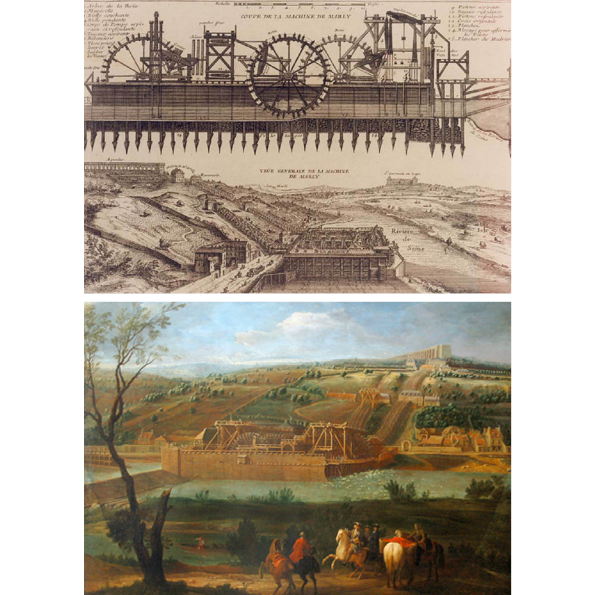
“It does not seem that one has ever completed a machine that has made as much noise in the world as that of Marly..." - Bernard Belidor , Architecture Hydraulique, 1737
When King Louis XIV chose Versailles as the site of his palace he had a problem, it was at the top of a hill with no natural supply of water. The grandeur of the gardens was dependent on fountains and this required an enormous capacity of water. The solution was to pump the water from the Seine, however the water was 10 km away, and 150m below the level of the gardens. To solve this in 1682 the Machine de Marly was built. This behemoth pumped water from the Seine, 700m up the hill into the Louveciennes aqueduct, just above the level of the gardens. From there it could run downhill into the palace reservoirs.
The pump was one of the most ambitious projects of the 17thC, built almost 200 years before the height of the industrial revolution. Walloonian miners, experienced in removing water from the deep coal pits, were brought in to create the pump. 1800 workers built the system and in modern currency cost $100 million. Power for the pumps was from the Seine itself with 14 water wheels, each 12m in diameter and 4.5m wide. Due to the limited strength of the leather that made up the pump valves, pressure was not high enough to complete the elevation of the water in one go, leading to construction of two relay stations. These were powered by the water wheels at the hill’s base, with energy transmitted through a flatrod system of rigid oscillating poles.
When the system first became operational it delivered 700hp, pumping 5000m3 of water daily. However this was only 83% of the planned total. It required a constant staff of over 60 plumbers, blacksmiths, woodworkers and engineers to keep running as parts would break constantly due to the enormous forces acting upon it Fires would spontaneously erupt because of the heat in the driveshafts caused by the machine's friction, leading to the construction of an early fire suppression system built into the pumphouse roof.
As the pump aged, its capacity dropped, by 1798 it moved only 640m3 daily, and in 1817, after 133 years of use, it failed and was replaced with a series of more modern machines. Due to its lower than expected capacity it did not provide enough water for the fountains of Versailles, instead its water was used for the fountains of another of Louis XIV’s local places, the Palace de Marly.
← Back to Lexicon
The Machine de Marly
Sources: Nicolas de Fer, Elevation and perspective of the Machine de Marly, c. 1715
Sources: Nicolas de Fer, Elevation and perspective of the Machine de Marly, c. 1715
